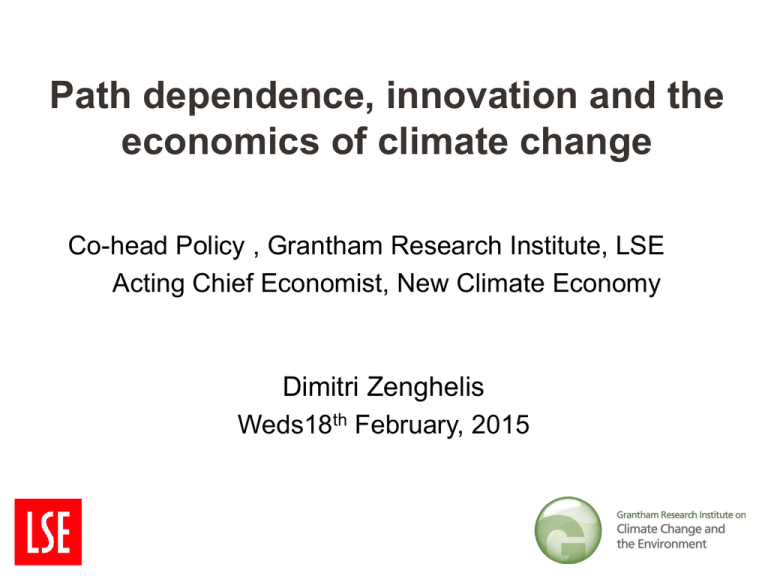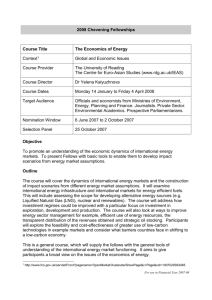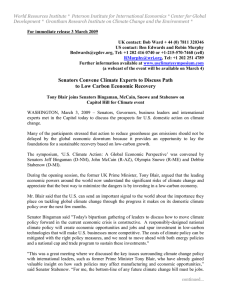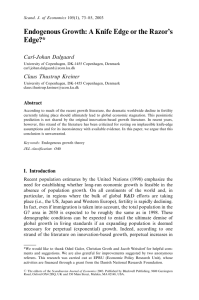Path dependence, innovation and the economics of climate change Dimitri Zenghelis
advertisement

Path dependence, innovation and the economics of climate change Co-head Policy , Grantham Research Institute, LSE Acting Chief Economist, New Climate Economy Dimitri Zenghelis Weds18th February, 2015 1 Endogenous growth – innovation race • Thomas Malthus posited that finite resources would constrain humans’ ability to supply rising demand • But every mouth is born with a brain and knowledge and innovation weightless; helped us do more with resources we have • Knowledge the driver of capital productivity • Path dependent • Hard to unlearn what is learnt • Giant's shoulders and complex spillovers and interactions across sectors, institutions and behaviours Endogenous growth – innovation race • The concept of “knowledge capital” ~ similar to physical capital, but is dependent on a number of factors such as cumulative R&D expenditures and physical and human capital investment • New equipment enables new ideas and innovation in technologies. • E.g. investing in computers induces bright ideas on how to use them • Investment in physical and knowledge capital drives increasing returns to scale in production (Smith, 1776), where more knowledge begets increased output and liberates resources for further investment and economic growth enlarges markets and permits greater specialisation and variety (Young, 1928, Romer 1990/1994 Solow 1999) • Even in a materially stationary state, indefinite growth in wellbeing is possible because of progress in the intellectual economy • A virtuous growth spiral in which future output becomes “pathdependent.” It’s what Malthus (and many others) missed Every stage of innovation is path dependent Traditional economic models: a bad joke? Lock in Lock in: Choices today create path dependencies for decades to come ATLANTA Population: 2.5 million Urban area: 4,280 km2 Transport CO2 pp: 7.5 tCO2e BARCELONA Population: 2.8 million Urban area: 162 km2 Transport CO2 pp: 0.7 Source: Bertaud, A. and Richardson, A.W (2004), Transit and density: Atlanta, the United States and Western Europe, Figure 17.2 on p.6, available at http://courses.washington.edu/gmforum/Readings/Bertaud_Transit_US_Europe.pdf and Kenworthy (2003), Transport Energy Use and Greenhouse Gases in Urban Passenger Transport Systems: A Study of 84 Global Cities, Third Conference of the Regional Government Network for Sustainable Development, Notre Dame University, Fremantle, Western Australia, September 17-19, 2003, Figure 1 on p.18 cited in Lefevre, B. (2009), Urban Transport Energy Consumption: Determinants and Strategies for its Reduction, S.A.P.I.EN.S 2(3): 1–32, Figure 6, available at http://sapiens.revues.org/914]. The reference year is 1995, with the exception of the population data which is from 1990. 13 Cities Cities with higher density tend to have lower carbon emissions Population density and CO2 emissions per capita in 73 OECD metropolitan areas, 2006 Japan and Korea North America Europe Source: Call for evidence contribution by the OECD Policy recommendations Clean energy R&D not sufficiently ambitious; risks creating greater lock-in to dirty infrastructure that is costly to reverse. Government support to include underwriting national green infrastructure projects and supporting basic clean energy research. Once kick-started, low-carbon economy could be more innovative/productive than a high-carbon economy. Innovation ‘spillovers’ are 40 per cent greater in low-carbon innovation than in conventional innovation. Carbon taxes need only be temporary because the energy and economic system will become locked-in to a low-carbon technology base. Shale gas and CCS helpful as a bridge to full decarbonisation, but risk delaying or disrupting the transition to fully clean technology. Policy to discourage – or ‘lock-out’ – gas without carbon capture and storage in long run. Innovation will determine our ability to get more out of resources we have. In a complex system; easier to drive change than to predict it leadership! Reading Ackerman, F. and Daniel, J., 2014. (Mis)understanding Climate Policy: The role of economic modelling. Synapse Energy Economics, Cambridge MA. Prepared for Friends of the Earth and WWF-UK. Available at: https://www.foe.co.uk/sites/default/files/downloads/synapsemisunderstanding-climate-policy-low-res-46332.pdf. Aghion, P.; Howitt, P.; (2009) The economics of growth. Massachusetts Institute of Technology (MIT) Press: Cambridge, US. http://discovery.ucl.ac.uk/17829/ Aghion, P., Hepburn, C., Teytelboym, A., and Zenghelis, D., (2014). Path-dependency, innovation and the economics of climate change. Simon Dietz & Nicholas Stern, (2014). Endogenous growth, convexity of damages and climate risk: how Nordhaus’ framework supports deep cuts in carbon emissions, GRI Working Papers 180, Grantham Research Institute on Climate Change and the Environment. http://www.lse.ac.uk/GranthamInstitute/wp-content/uploads/2014/06/WorkingPaper-159-Dietz-and-Stern-2014.pdf Global Commission on the Economy and Climate, 2014. Better Growth, Better Climate: The New Climate Economy Report, Chapter 5, Available at http://newclimateeconomy.report Mazzucato, M. (2011), The Entrepreneurial State, London: Demos. Stern, N (2007): The economics of climate change, Cambridge University Press, Cambridge End New Climate Economy – just another report? • • • • • • • • • • • Short run 10-15 years – politically relevant Focus on growth and development Many co-benefits Some static some dynamic Spill-overs and complementarities But can we access them? Political economy and structural reform Ultimately, innovation determines ability to get more out of resources we have – green and grow On shoulders of giants but also giants on our shoulders Expanding “knowledge capital” - e.g. investing in computers induces bright ideas on how to use them Increasing returns to scale in production (Smith 1776– Malthus forgot every mouth comes with a brain, Romer 1990/1994 Solow 1999) Even in a materially stationary state, indefinite growth in well-being is possible because of progress in the intellectual economy



